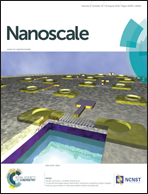Schottky barrier-gated high performance photodetectors using a water-borne polymeric colloid†
Abstract
Here, we demonstrate the synergetic application of a cationic surfactant (CTAB) for the fabrication of a fast response organic photoconductor via an environmentally benign fabrication process. A water-borne colloid of the semiconducting polymer PBTTT was fabricated via a mini-emulsion process with CTAB as the surfactant, and deposited onto a Au-patterned substrate to complete the photoconductor device geometry. Due to the preferential adsorption of the ammonium cation of the CTAB molecules onto the Au surface, a dipole layer was created and thus the work function of Au was significantly reduced, as confirmed by ultraviolet photoelectron spectroscopic studies. We show that the resulting Schottky barrier between Au-CTAB and PBTTT can be used as an artificial ‘gate’ for a trap-limited photoconductive mechanism, leading to a fast temporal response of the photoconductor without sacrificing the efficient photoconductive gain-generating mechanism. As a result, a high detectivity of 4.92 × 1010 Jones, as well as a high gain of 107, can be realized from the PBTTT-based organic photoconductor. This result opens the possibility of fabricating high performance and simple structured organic photodetectors via a nontoxic fabrication process.


 Please wait while we load your content...
Please wait while we load your content...